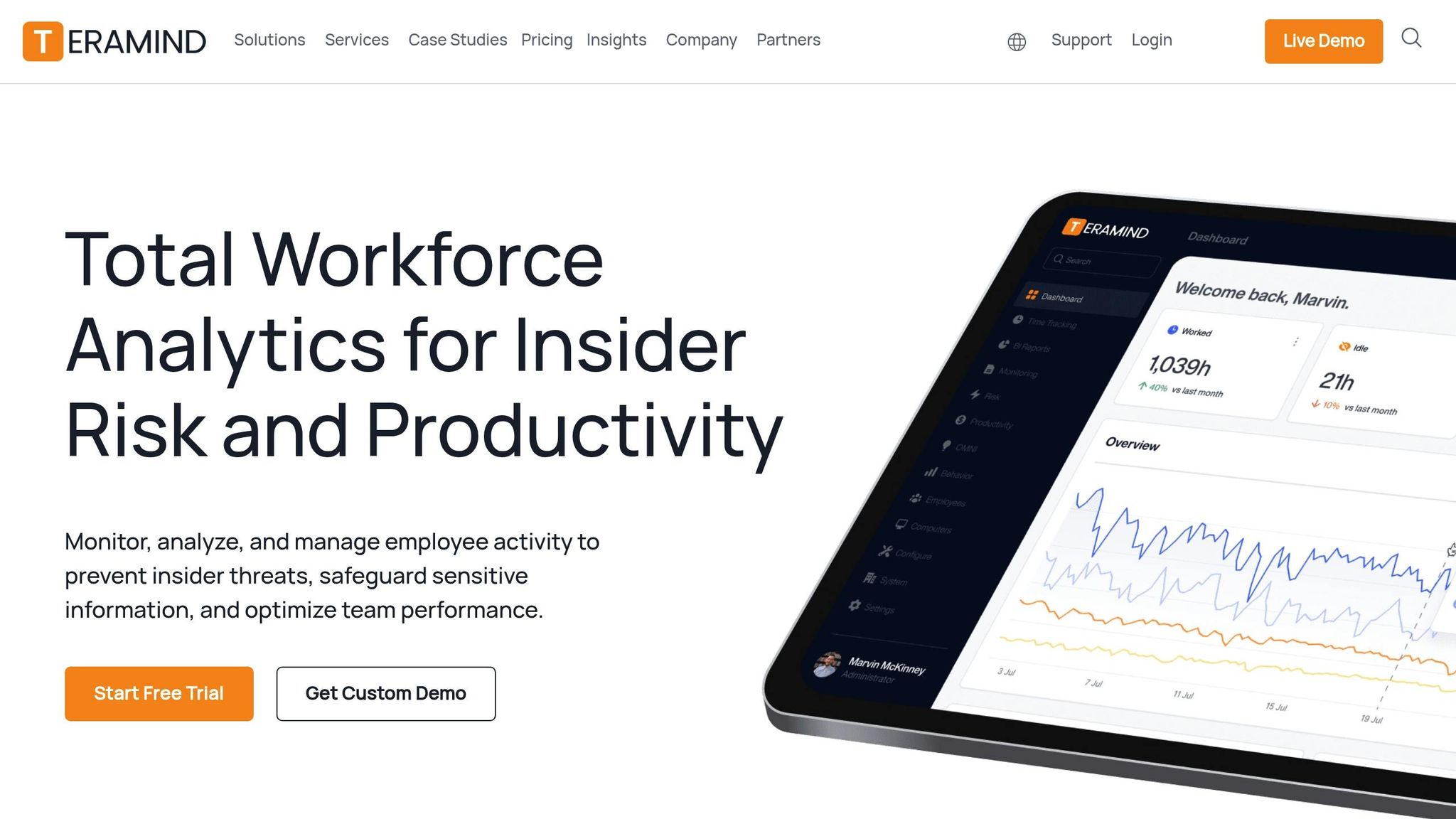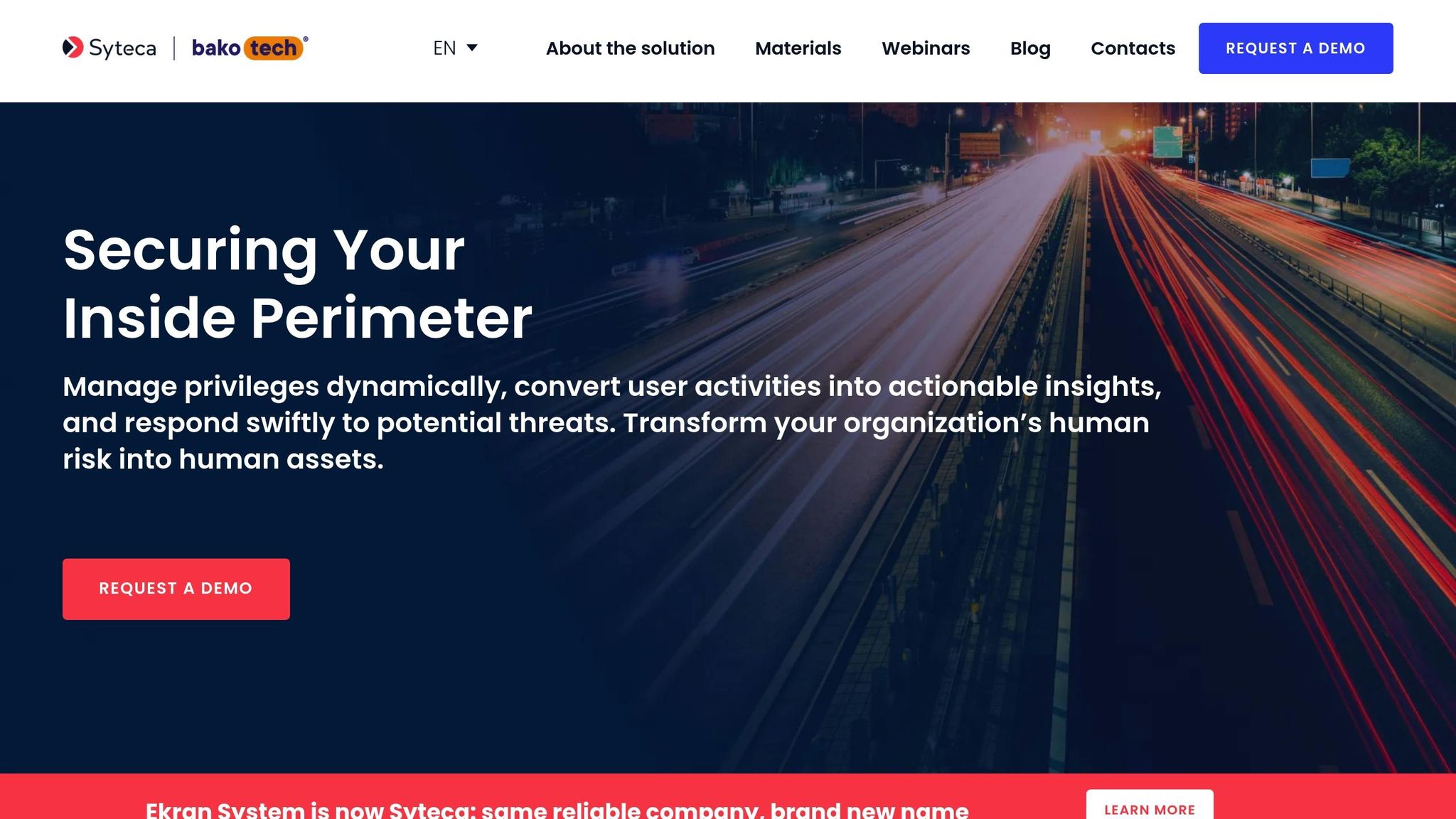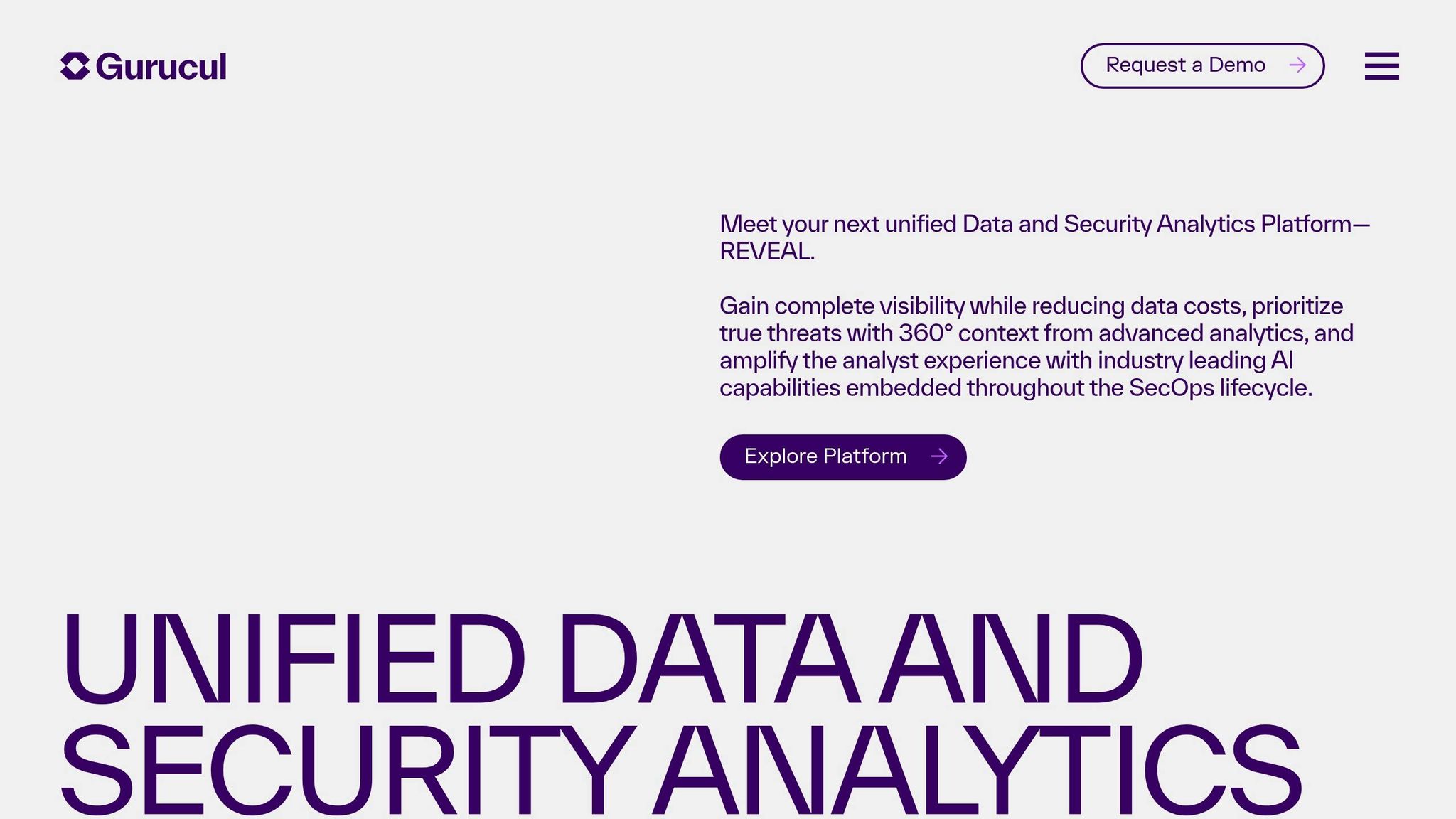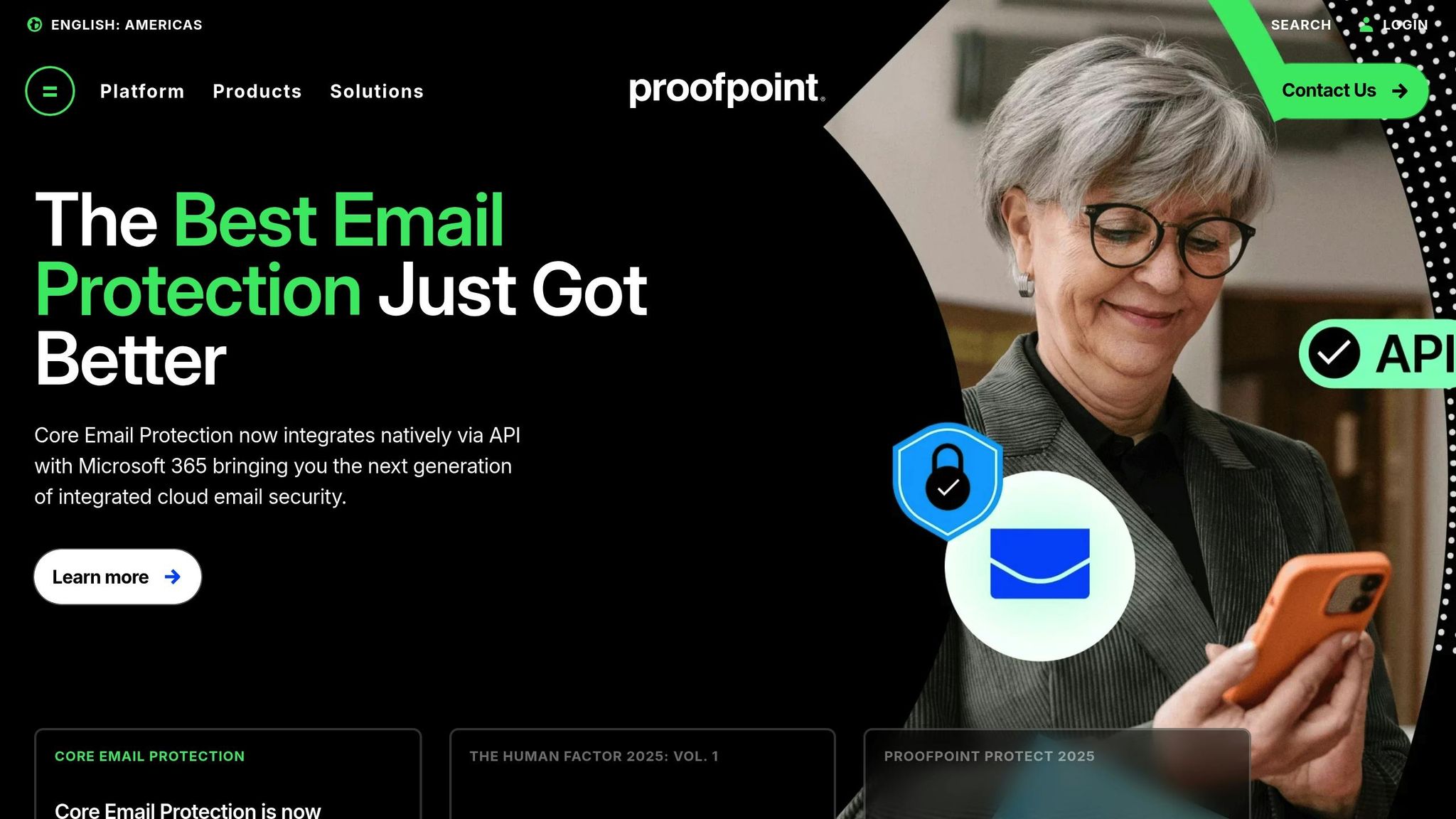Insider threats are a growing concern for businesses, with 83% of organizations reporting incidents and an average breach cost of $16.2 million. Behavioral analytics tools help by monitoring user activity, identifying anomalies, and reducing false positives by up to 80%. These tools are essential for detecting both malicious and accidental threats, ensuring compliance, and protecting sensitive data.
Here are five top tools for managing insider threats:
- Teramind: Combines user behavior analytics with endpoint monitoring, offering real-time alerts and seamless integration with security systems.
- Syteca: Focuses on privileged access management and compliance, providing detailed monitoring and automated responses.
- Forcepoint: Tracks user behavior and data movement, offering risk-based alerts and dynamic policy enforcement.
- Gurucul: Uses machine learning to create dynamic user profiles, reducing false positives and improving threat detection.
- Proofpoint: Specializes in data loss prevention, with detailed user activity tracking and endpoint protection.
These tools integrate with existing security systems like SIEM and DLP platforms, offering tailored solutions to fit organizational needs.
Quick Comparison
| Feature | Teramind | Syteca | Forcepoint | Gurucul | Proofpoint |
|---|---|---|---|---|---|
| Behavioral Analytics | Baseline anomalies | Privileged access focus | User-data interaction | Machine learning models | Data movement tracking |
| Real-Time Alerting | Prioritized alerts | Customizable notifications | Risk-based alerts | Risk scoring system | Endpoint notifications |
| Integration Options | SIEM, DLP, ITSM | SIEM, PAM, UAM | Flexible security setups | Cloud and security tools | SIEM, MIP, AWS S3 |
| Compliance Support | Audit logs, reporting | Automated controls | Policy-based enforcement | Risk scoring for audits | Pre-built compliance rules |
Each tool offers unique capabilities. Your choice should align with your organization’s specific needs, whether it’s advanced analytics, compliance support, or robust data protection.
1. Teramind

Teramind is a behavioral analytics platform that combines User and Entity Behavior Analytics (UEBA) with detailed endpoint monitoring. By establishing a baseline of typical user activity, it identifies deviations that could indicate malicious or negligent behavior. The platform monitors network activity through tools like screen recordings, keystroke tracking, and application logs.
Behavioral Analytics Capabilities
When integrated with existing security systems, Teramind strengthens threat detection and response. Its behavioral analytics engine doesn’t just track activity – it establishes patterns of normal behavior and flags anomalies, such as accessing restricted files or downloading large amounts of data.
The platform is particularly effective at spotting insider threats. For example, it detects unusual login attempts outside of normal hours. If sensitive data is downloaded, emailed, or printed, Teramind can automatically respond based on pre-set security policies.
One financial services firm successfully prevented data breaches by quickly identifying unauthorized access to sensitive information using Teramind’s analytics. By analyzing current behavioral patterns, the platform helps predict potential security risks, keeping organizations one step ahead of threats.
These insights feed into real-time alerts, providing security teams with actionable information to prioritize their responses effectively.
Real-Time Alerting
Teramind’s AI-driven alert system, OMNI, revolutionizes how security teams manage threats. OMNI prioritizes alerts, ensuring that the most critical risks are addressed first, cutting through the noise of false positives.
You can configure alerts for high-risk activities like attempts to access large volumes of sensitive data, connecting unauthorized external devices, or installing prohibited software. These alerts can trigger automated responses, such as restricting user access or initiating additional monitoring.
"It’s been an amazing experience and a wonderful software that does exactly what you want! Security, control, peace of mind, the ability to know all that is going on in the organization. Very easy to use. It gives you real data! It has given us the protection that we need!" – Rene H., Head IT Security
Teramind’s ability to integrate with other tools enhances its proactive monitoring capabilities across your security ecosystem.
Integration Options
Teramind seamlessly connects with existing security systems using its API and pre-built connectors. It integrates with SIEM platforms like Splunk, IBM QRadar, and HP ArcSight, improving threat detection and incident response by automating data transfer and normalizing data for easier analysis.
For identity management, Teramind works with Active Directory, Azure Entra, and SSO solutions, simplifying user authentication and management. It also integrates with Data Loss Prevention (DLP) tools like Microsoft Purview Information Protection, enabling organizations to discover, classify, and secure sensitive data.
Additionally, Teramind connects with ITSM platforms like ServiceNow, streamlining incident management with features like video recordings, event logs, and OCR search capabilities for exposed sensitive data. This reduces investigation times by providing detailed documentation for security operations teams.
"Easy Implementation, Great UI, and amazing product. We leverage Teramind to manage high-risk situations to get in-depth visibility and alerting. It has far surpassed our expectations and has saved us significant data loss." – IT Security & Risk Manager, $7B Manufacturing Enterprise
Beyond security tools, Teramind integrates with project management platforms like JIRA and Zendesk, as well as Business Intelligence systems. These integrations provide actionable insights that enhance decision-making and reduce risks. For instance, one mid-sized organization reported a 30% boost in project completion rates after using Teramind to identify and resolve inefficiencies in task management.
2. Syteca Insider Risk Management

Syteca focuses on managing insider risks by analyzing human behavior, monitoring employee and third-party activities across corporate networks. By combining User Activity Monitoring (UAM) with Privileged Access Management (PAM), it provides a robust defense against insider threats.
What makes Syteca stand out is its ability to cover the entire risk management process. From continuous behavioral monitoring to automated incident response, the platform offers a full view of your infrastructure. This includes advanced monitoring, session recording, and detailed metadata analysis. These features form the backbone of its real-time alerts and compliance management, making it easy to integrate into your current security setup.
Behavioral Analytics Capabilities
Syteca employs User and Entity Behavior Analytics (UEBA) to create behavioral profiles by tracking activities like logins, file access, and application use. It flags unusual actions – such as accessing sensitive files after hours or abnormal system usage – for immediate attention.
A key feature is its ability to detect unmanaged privileged accounts, which can be security blind spots. Syteca ensures proper user authorization, controls access permissions, and securely manages and shares passwords, all while keeping a close watch on privileged user activities.
"Syteca provides comprehensive tools for monitoring, recording, identity management, access control, anomaly alerts, and two-factor authentication. The platform is also unique in its ability to withstand large loads and record activities at all checkout points in our branch offices." – Nir Ben Zion, IT & Cloud Director at Super-Pharm
Real-Time Alerting
Speed is critical when dealing with insider threats, and Syteca addresses this with its real-time alerting system. According to the 2025 Ponemon Institute Cost of Insider Risks Report, it takes an average of 81 days to detect an insider incident. Syteca shortens this timeline significantly with customizable notifications that alert security teams as soon as suspicious activity is detected.
The platform supports rule-based incident response actions that can automatically block malicious users or processes without requiring immediate human input. Alerts can be set for high-risk actions like attempts to access restricted databases, unusual file transfers, or unauthorized USB connections.
This proactive approach can save organizations substantial costs. Large companies spend an average of $26.2 million annually addressing insider incidents, while smaller organizations spend $7.7 million. By identifying threats early, Syteca helps reduce both the time and financial impact of such incidents.
Compliance Support
Syteca also strengthens security by automating compliance processes. It simplifies adherence to regulations like GDPR, HIPAA, PCI DSS, and SOX through automated controls, audit trails, and secure access management. Its detailed audit trails and session recordings serve as essential documentation for regulatory audits and incident investigations.
For financial institutions subject to the Digital Operational Resilience Act (DORA), Syteca offers tailored features to meet requirements for secure data handling and operational resilience.
"In order to comply with regulations and corporate policy rules, we wanted to ensure uninterrupted privileged user audit, as well as provide local and remote employee activity monitoring. That’s why we chose Syteca, an easy-to-use and affordable solution that met our full expectations." – Kelvin Goh, Managing Partner at Global B2B Consultancy
Integration Options
Syteca integrates effortlessly with existing security systems, including identity management platforms, SIEM tools, and other security solutions. This creates a unified view of your organization’s security landscape.
The platform’s PAM and UAM features work seamlessly with current authentication systems, allowing you to maintain established workflows while enhancing monitoring and access control. It can also manage USB device usage, generate detailed reports, and automate incident responses – all within your existing IT environment.
This integration capability is especially valuable for organizations with complex IT setups that need to strengthen insider threat protections without disrupting operations.
3. Forcepoint Insider Threat

Forcepoint Insider Threat leverages advanced behavioral analytics to keep a close eye on how users interact with sensitive data, providing a full picture of risks posed by insider actions – whether intentional or accidental.
What makes Forcepoint stand out is its ability to connect user behavior with data movement patterns. This unique capability helps security teams not only track user activity but also understand how those actions influence the flow of sensitive information within the organization. By monitoring file access and transfer habits, the system establishes user baselines, making it easier to spot unusual activity.
Behavioral Analytics Capabilities
Forcepoint’s behavioral analytics engine creates a clear baseline for each user by analyzing their typical interactions with systems and data. By studying how users access and share files, the platform builds detailed profiles that serve as a foundation for detecting potential threats.
The platform excels at identifying deviations from these baselines, which could signal risky behavior. For example, if an employee suddenly downloads a large number of sensitive files at an odd hour, such as 2:00 AM, the system will generate an alert immediately.
Risk scoring is tailored to individual user roles, ensuring that security teams can focus on real threats while minimizing false alarms.
"Forcepoint combines visibility and analytics to help you understand how users interact with critical data and stop risky behaviors ‘left of loss.’" – Forcepoint
The platform doesn’t just look for malicious actions – it also identifies accidental risks, such as employees unintentionally putting sensitive data at risk through careless file sharing or unsafe practices.
Real-Time Alerting
Forcepoint’s real-time alerting system kicks in as soon as a user’s behavior deviates from their established baseline, providing crucial context for quick decision-making.
Instead of flagging every anomaly, Forcepoint’s alerts come with detailed background information, such as typical user behavior and recent access history. This added context helps security analysts assess the severity of the situation more effectively.
Organizations using Forcepoint have reported a 70% reduction in the time it takes to triage incidents. The platform’s automated tools can even block compromised users if high-risk behavior is detected, preventing potential data breaches. This proactive functionality is particularly important as 74% of companies report that insider threats are on the rise and consider themselves at least moderately vulnerable.
These real-time insights integrate smoothly into broader security systems, enhancing overall protection.
Integration Options
Forcepoint works well with existing IT setups, enriching current workflows with powerful behavioral monitoring.
For companies in highly regulated sectors, Forcepoint can be configured to flag any attempts to access restricted data, ensuring compliance with industry standards. On the other hand, organizations with more flexible data-sharing policies can adjust the system to focus on unusual activities, such as transferring data to personal devices.
4. Gurucul

Gurucul brings together User and Entity Behavioral Analytics (UEBA) and machine learning to offer a powerful security platform that doesn’t require a specialized data science team. By merging security, identity, and HR data into a single, unified view, Gurucul equips security teams with the context they need to identify and respond to potential threats effectively.
Instead of relying on static rules, Gurucul uses dynamic peer-group baselines. This means the platform is constantly learning what "normal" looks like for different user groups, making it better at identifying unusual and potentially harmful activities. With more than 3,000 pre-built machine learning models ready to use, organizations can tailor their threat detection without needing deep technical expertise.
Behavioral Analytics Capabilities
Gurucul’s behavioral analytics engine creates in-depth profiles by analyzing how users interact with systems, applications, and data throughout the organization. By pulling information from multiple sources – such as security logs, identity management tools, HR systems, devices, and data repositories – the platform builds a comprehensive picture of user and entity behavior patterns.
It’s designed to catch even the smallest deviations. For instance, if an employee who typically accesses financial records during the day suddenly downloads a large volume of data at night, Gurucul flags it as an anomaly. The system doesn’t just look at isolated actions; it also analyzes sequences of behavior to uncover potential attack patterns.
"By converging data from multiple sources and applying industry-leading behavioral analytics, Gurucul’s insider threat software breaks down traditional barriers, predicts malicious activities, and effectively mitigates insider threats." – Gurucul
This comprehensive approach helps detect compromised accounts or systems that could be exploited for insider attacks.
Real-Time Alerting
Gurucul’s real-time detection system provides actionable insights while keeping false alarms to a minimum. The platform uses a 0–100 risk scoring system, allowing security analysts to quickly identify and prioritize incidents that need immediate attention. Its machine learning models continuously compare behavior against established baselines, triggering alerts when suspicious activities are detected. Impressively, Gurucul claims to reduce false positives by up to 99% compared to traditional security tools.
When an alert is generated, it includes detailed context – such as the user’s typical behavior, recent activities, and associated risk factors – helping analysts make fast, informed decisions. The platform also correlates seemingly unrelated events to provide a more complete view of potential threats. This allows security teams to understand and address risks before they escalate. Additionally, Gurucul’s alerting capabilities integrate seamlessly with existing security systems, strengthening overall organizational defenses.
Integration Options
One of Gurucul’s standout features is its ability to integrate smoothly with existing security infrastructure. Thanks to its flexible connector framework, the platform can ingest data from enterprise applications, cloud services, devices, and other systems without requiring significant changes to current workflows.
For organizations already using tools like DLP, PAM, or EDR solutions, Gurucul adds value by providing behavioral insights and supporting automated incident responses. It also integrates with Vault systems to securely retrieve credentials needed for accessing various data sources.
This flexibility ensures that Gurucul can adapt to evolving security needs without requiring a complete overhaul of an organization’s technology stack, making it easier to incorporate new integrations as systems grow and change.
sbb-itb-ce552fe
5. Proofpoint Insider Threat Management

Proofpoint Insider Threat Management (ITM) provides real-time insights into insider activities – a crucial feature given that insiders are involved in 25% of security incidents.
What makes Proofpoint ITM stand out is its ability to offer detailed visibility into user behavior through timeline views and screen captures. It actively prevents data exfiltration across USB drives, web platforms, cloud services, and even print channels.
"An insider threat can happen when someone close to an organization with authorized access misuses that access to negatively impact the organization’s critical information or systems." – Proofpoint
Below, we explore the platform’s key features in greater detail.
Behavioral Analytics Capabilities
The platform’s analytics engine focuses on four primary risk areas: unauthorized access, accidental data exposure, system misuse, and policy-violating data movement. These risks are identified using pre-configured rules based on expert research.
Proofpoint ITM uses data-in-motion scanning to track sensitive data as it moves through the organization. This allows it to flag risky actions like unauthorized uploads or renaming of critical files. It collects telemetry data from endpoints, email systems, and cloud environments, consolidating everything into a centralized dashboard for easier management and oversight.
While its strength lies in preventing data loss, the platform may not offer advanced anomaly detection features, such as baseline behavior analysis, which could be a limitation for some organizations.
Real-Time Alerting
Proofpoint ITM’s alerting system is designed for quick incident response. It sends real-time notifications whenever suspicious activities are detected, enabling security teams to investigate and address issues across endpoints, web platforms, cloud services, and email environments.
"Proofpoint insider threat management (ITM) provides visibility into risky behavior that leads to business disruption and revenue loss by careless, malicious and compromised users." – Proofpoint
The platform not only blocks data loss but also uses on-screen prompts to guide users in the moment, helping them correct risky actions. Its unified console is equipped with intuitive visualizations, making it easier for security teams to track and correlate alerts across various channels. Additionally, it includes pre-built alert libraries, allowing for quick deployment and immediate functionality.
Integration Options
Proofpoint ITM is built to integrate seamlessly with existing security systems. It works with SIEM solutions, Microsoft Information Protection (MIP), and offers webhooks and a RESTful API for custom automation.
One standout feature is its ability to automatically export data to AWS S3 storage, ensuring compatibility with even the most complex security setups. This flexibility makes it an excellent choice for organizations looking to enhance their insider threat detection without overhauling their current security workflows.
Feature Comparison Table
When selecting a behavioral analytics tool, it’s vital to understand the core security features each platform brings to the table. The five tools reviewed here – Teramind, Syteca, Forcepoint, Gurucul, and Proofpoint – offer distinct approaches to insider threat detection, each excelling in areas like analytics, alerting, and integration. Here’s a breakdown of their key capabilities:
| Feature | Teramind | Syteca | Forcepoint | Gurucul | Proofpoint |
|---|---|---|---|---|---|
| Behavioral Analytics | Intelligent anomaly detection with baseline creation for routine activities | Pattern recognition for abnormal behavior detection | Combines behavioral analytics with automated enforcement | Behavior-based risk scoring with machine learning models | Visual, chronological tracking of user actions and detection of risky behavior |
| Real-Time Alerting | Newsfeed-style dashboard with prioritized critical alerts | Detects abnormal behavior patterns with immediate alerts | Dynamic policy enforcement based on individual risk levels | Comprehensive risk-based alerting system | Real-time notifications with on-screen prompts across endpoints |
| Machine Learning & AI | Pattern recognition and baseline establishment | ML algorithms for threat detection | Advanced behavioral modeling | Continuous learning and adjustment to new activities | Rule-based detection with limited anomaly detection |
| Compliance Support | Forensic investigation tools and activity monitoring | Automated controls and reporting tools aligned with industry standards | Policy-based compliance enforcement | Risk scoring to support regulatory compliance | Data loss prevention across multiple channels |
| Integration Options | Third-party security tool compatibility | SIEM and security system integration | Enterprise security platform integration | Analytics-driven approach with identity context | SIEM, Microsoft Information Protection, RESTful API, AWS S3 export |
| Automated Response | Yes, with investigation capabilities | Yes, with immediate threat response | Yes, with dynamic policy enforcement | Yes, with immediate threat detection | Yes, with on-screen prompts for guiding users and blocking risky actions |
| User Monitoring | Comprehensive user activity tracking | Continuous behavior monitoring | Individual behavior and risk assessment | User and entity interaction analysis | Visual timeline views with screen captures |
This table provides a clear snapshot of each platform’s strengths, helping you align your organization’s security needs with the right solution.
Key Highlights
- Teramind: Known for its forensic investigation tools and detailed user activity tracking, making it ideal for organizations needing in-depth monitoring capabilities.
- Syteca: Stands out with automated compliance and reporting, a valuable feature for industries with strict regulatory requirements.
- Forcepoint: Offers dynamic policy enforcement that adapts to individual risk levels in real time. This proactive approach helps prevent data exfiltration as it happens, rather than reacting after the fact.
- Gurucul: Leverages machine learning models that continuously adapt to new activities, providing behavior-based risk scoring. This makes it particularly effective for organizations managing complex and evolving user behaviors.
- Proofpoint: Focuses on data loss prevention, blocking unauthorized actions across multiple channels. Its integration options, such as AWS S3 export and Microsoft Information Protection, make it well-suited for intricate security environments.
"Splunk UBA is giving us deep insight into our insider threat and what our trusted users are doing at any given instant." – Martin Luitermoza, Associate Vice President, NASDAQ
Considering that 83% of companies encountered insider threats last year, with an average cost of $16.2 million per incident, choosing the right tool is more critical than ever. Whether your priority is advanced machine learning, detailed forensic tools, or robust data loss prevention, there’s a solution tailored to your needs.
Integration with Security Systems
Behavioral analytics tools are most effective when seamlessly integrated with existing security frameworks. The five platforms we’ve explored – Teramind, Syteca Insider Risk Management, Forcepoint Insider Threat, Gurucul, and Proofpoint Insider Threat Management – are designed to connect with systems like surveillance networks, access control platforms, and managed security services. This integration strengthens the overall security posture by creating a cohesive defense strategy.
Creating a Unified Security Ecosystem
Modern security operations thrive on systems that share data effortlessly. By linking behavioral analytics tools with platforms like SIEM (Security Information and Event Management), SOAR (Security Orchestration, Automation, and Response), and EDR (Endpoint Detection and Response), organizations gain centralized monitoring and streamlined response workflows. This setup allows security teams to identify insider threats by correlating access patterns with behavioral anomalies, such as unusual file access frequency or misuse of privileged accounts.
The integration process relies on REST APIs and standardized protocols. For instance, if an employee accesses sensitive files at odd hours – outside their typical behavior – the system can instantly trigger alerts across multiple connected security platforms.
Real-World Integration Applications
Real-time integration proves invaluable in detecting unusual access to sensitive data. For example, companies can monitor user interactions with SaaS platforms to spot irregularities in data access or prevent credential misuse by analyzing deviations from normal user activity. Similarly, combining behavioral analytics with access control systems – like keycards or biometric authentication – enhances security. Adding video surveillance to the mix enables organizations to monitor critical areas, detect unauthorized access attempts, and aid in incident investigations. This approach links camera feeds directly to access events, creating a more comprehensive security framework.
Operational Benefits of Integrated Systems
Integrated security systems offer real-time monitoring across multiple locations, supported by live video feeds and instant alarm notifications. This setup improves response times by automating alerts and providing detailed incident documentation. Centralized data management also delivers actionable insights through detailed reports and behavioral analysis. Early detection of suspicious activity allows organizations to act proactively, reducing the risk of breaches [46, 47].
Best Practices for Successful Integration
To fully leverage integration, organizations should start by defining clear security objectives and threat models. Establishing baselines and criteria for anomalies ensures that behavioral analytics tools operate effectively. It’s equally important to ensure that platforms like SIEM, SOAR, and EDR can process and act on behavioral alerts. Regular updates to behavioral models, combined with training analysts to interpret alerts accurately, help reduce false positives and prevent alert fatigue. Monitoring behavioral trends and adjusting thresholds over time ensures reliability and keeps the system effective.
Professional Implementation and Management
Building on the capabilities of the reviewed platforms, ESI Technologies provides tailored integration solutions for U.S. businesses. Their approach combines behavioral analytics with surveillance systems, access control, and 24/7 managed security services. Certified technicians oversee the integration process, ensuring real-time alerts and centralized monitoring across various platforms. ESI Technologies also offers ongoing maintenance, updates, and round-the-clock support to help businesses adapt to evolving threats.
For organizations working with government agencies, it’s critical to ensure compliance with standards like FedRAMP authorization. As of August 1, 2025, the FedRAMP Marketplace includes 451 authorized services, offering a valuable resource for identifying compliant cloud service providers.
Conclusion
Behavioral analytics tools have become essential in tackling insider threats, offering a proactive edge that traditional security methods simply can’t provide. These tools equip modern security teams with the ability to stay ahead of increasingly sophisticated threats.
To recap, the platforms we’ve covered – Teramind, Syteca Insider Risk Management, Forcepoint Insider Threat, Gurucul, and Proofpoint Insider Threat Management – each bring distinct strengths to the table. They excel at detecting both malicious and accidental insider threats by creating behavioral baselines and identifying unusual patterns that could indicate potential risks.
"Behavioral analytics is an essential part of your cybersecurity arsenal. To identify subtle patterns of behavior, detect threats, and aid in post-incident investigation, organizations need behavioral analytics." – Lucia Stanham, Product Marketing Manager, CrowdStrike
These tools seamlessly integrate with existing security systems, making them indispensable for organizations aiming to enhance their defenses. When selecting the right platform, it’s crucial to align your choice with your organization’s specific needs. Consider whether you require User Behavior Analytics (UBA) for monitoring individual actions, User and Entity Behavior Analytics (UEBA) for broader coverage that includes devices and applications, or Network Behavior Analytics (NBA) to analyze traffic patterns.
Effective implementation goes beyond just choosing the right tool. Integration with systems like SIEM, SOAR, and EDR is critical for creating a unified defense strategy. This integration allows for real-time correlation between access patterns and behavioral anomalies, improving response times and cutting down on false positives.
Success also depends on meticulous planning and ongoing management. Start by establishing behavioral baselines tailored to roles and departments, and review these baselines regularly – quarterly updates are a good practice. Train your security team to interpret alerts effectively and set up clear workflows to ensure swift action on legitimate threats.
For organizations seeking comprehensive support, ESI Technologies offers tailored solutions that combine behavioral analytics with surveillance systems, access control, and 24/7 managed security services. Their certified experts ensure smooth deployment and provide the continuous monitoring and real-time alerts needed to stay ahead of insider threats.
With insider attacks on the rise, investing in behavioral analytics tools and integrating them into your security infrastructure isn’t just about protecting data – it’s about building a forward-thinking, adaptable security posture that’s ready for whatever challenges the future may bring.
FAQs
How do behavioral analytics tools help reduce false alarms when detecting insider threats?
Behavioral analytics tools help cut down on false alarms by digging into contextual data like user roles, past activity patterns, and real-time behavior. By pinpointing what "normal" looks like for a specific user or role, these tools can better distinguish between harmless actions and suspicious ones.
With methods such as data modeling and behavioral pattern analysis, these tools spot anomalies that genuinely signal risk while filtering out insignificant deviations. This sharper focus improves detection accuracy and limits distractions, enabling security teams to concentrate on real threats.
What are the benefits of integrating behavioral analytics tools with existing security systems like SIEM and DLP?
Integrating behavioral analytics tools with systems like SIEM (Security Information and Event Management) and DLP (Data Loss Prevention) can significantly boost your organization’s security efforts. This setup creates a centralized platform for monitoring user and entity behaviors, making it easier to spot unusual activities or potential insider threats.
By automating anomaly detection, this integration reduces the need for manual analysis, enabling faster responses to potential risks. It also enhances your ability to identify data exfiltration and other malicious activities, ensuring a more proactive stance in protecting sensitive information.
What should organizations consider when selecting a behavioral analytics tool to manage insider threats?
To find the best behavioral analytics tool for tackling insider threats, it’s important to focus on tools that match your security objectives and work smoothly with the systems you already have in place. Look for features like anomaly detection, risk scoring, and the ability to establish baseline behaviors. These capabilities are crucial for spotting unusual activities that could point to insider threats.
It’s also essential to consider your organization’s unique workflows and risk factors, including digital and behavioral warning signs. This understanding can help you choose tools that offer effective monitoring and deliver real-time alerts. Prioritizing these elements will strengthen your ability to identify and address insider risks more effectively.

